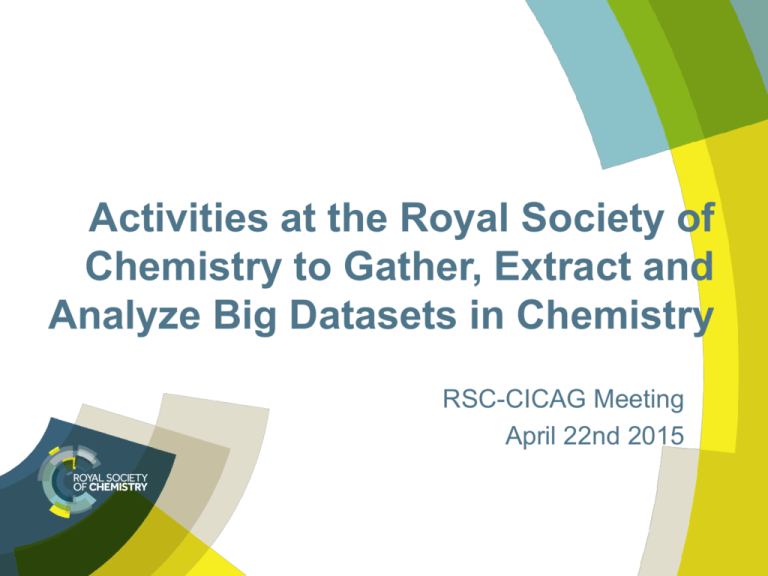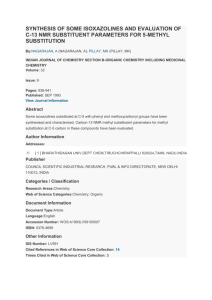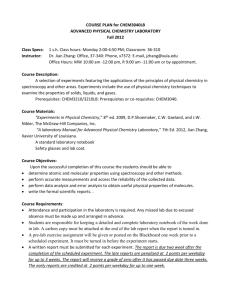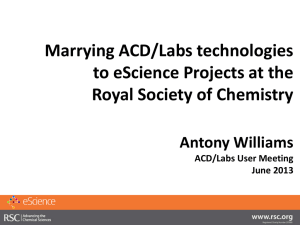Tony Williams - Royal Society of Chemistry
advertisement

Activities at the Royal Society of
Chemistry to Gather, Extract and
Analyze Big Datasets in Chemistry
RSC-CICAG Meeting
April 22nd 2015
What of the World of Chemistry?
What of the World of Chemistry?
Prophetic Enumeration
What of the World of Chemistry?
What of the World of Chemistry?
“The InChIKey indexing has therefore turned
Google into a de-facto open global chemical
information hub by merging links to most
significant sources, including over 50 million
PubChem and ChemSpider records.”
What of the World of Chemistry?
RSC’s ChemSpider
>34 million chemicals from >500 sources and
>40,000 users per day
Not Dealing With Big Data…
Is Openness Changing Things?
Open Access/Data Mandates
Open Access funder mandates…
We hear about the Open Data…
Chemistry Open Data???
• Where are all of the Open Chemistry Data?
• Is there a willingness to contribute more?
• Can we harvest more?
Chemistry Open Data???
• Where are all of the Open Chemistry Data?
• Not that much showing up yet from scientists
• Is there a willingness to contribute more?
• Can we harvest more?
Chemistry Open Data???
• Where are all of the Open Chemistry Data?
• Not that much showing up yet from scientists
• Is there a willingness to contribute more?
• Many concerns about IP and much lip service
• Can we harvest more?
Chemistry Open Data???
• Where are all of the Open Chemistry Data?
• Not that much showing up yet from scientists
• Is there a willingness to contribute more?
• Many concerns about IP and much lip service
• Can we harvest more?
• Yes
There are Efforts…
RSC >36,000 Articles in 2015
• Consider articles published by RSC in 2015
•
•
•
•
•
•
How many compounds?
How many reactions?
How many figures?
How many properties?
How many spectra?
How many, how many, how many?
The Graph of Relationships is Lost
The flexibility of querying…
IP?
What’s the
structure?
Are they in
our file?
What’s
similar?
Pharmacology
data?
What’s the
target?
Known
Pathways?
Competitors?
Connections
to disease?
Working On
Now?
Expressed in
right cell type?
Publications-summary of work
• Scientific publications are a summary of work
•
•
•
•
Is all work reported?
How much science is lost to pruning?
What of value sits in notebooks and is lost?
Publications offering access to “real data”?
• How much data is lost?
•
•
•
How many compounds never reported?
How many syntheses fail or succeed?
How many characterization measurements?
If I wanted to share data…
•
•
•
•
•
•
•
I’ve performed a few dozen chemical syntheses
I’ve run thousands of analytical spectra
I’ve generated thousands of NMR assignments
I’ve probably published <5% of all work..most lost
Things can be different today in terms of sharing
I would like to share more data, would like at
least provenance traced to me and somehow
to be acknowledged for the contribution
How Many Structures Can You
Generate From a Formula?
My research…in this CASE
Some NMR…
In researcher mode…
• I want to access and use data
• I want to:
•
•
•
•
•
Download molecules
Download tables
Download spectra
Download figures
Then reprocess, replot, repurpose
The Challenge of Data Analysis
• NO access to raw data files – in binary or even
standard file formats for processing
• Figures are close to USELESS for 2D NMR –
representative not accurate shifts
• Tabulated shifts are in PDF files and needed
transcribing – where are CSV files???
• TORTUROUS WORK!!!!
• What if we wanted to do this for all manuscripts
submitted to RSC? Of course it is Feasible…
Community Norms
• Some wonderful community norms & mandates!
•
•
•
•
Deposit crystal structures in CSD
Deposit Proteins in PDB
Deposit gene sequences in Genbank
Increasingly deposit bioassay data in Pubchem
But what of general chemistry?
• We publish into document formats
• Could publishers help drive a community
norm for:
•
•
•
•
Chemical compound registration
Spectral data
Property data
What else?
• Who would host it? How would it be funded?
Not even a References Standard
We can solve for Authors…
Will it be used though??? YES!
Moves in Supplementary Info
The challenges of analytical data
• Vendors produce complex proprietary data
formats and standard formats are required
(JCAMP, NetCDF, AniML)
•
•
•
ChemSpider already hosts thousands of JCAMP spectra
Data validation approaches understood
There are a myriad of analytical data types…
Analytical data
Encouraging data deposition
• Open Data mandates don’t offer solutions
• We would like to host:
• Compounds, Reactions, Spectra, Images,
Figures, Graphs etc.
• We will offer embargoing, collaborative sharing
and public release of data
• Integration to Electronic Lab Notebooks and
Institutional Repositories for deposition
RSC Repository Architecture
doi: 10.1007/s10822-014-9784-5
Registering of Data
• We hear…“We need standards”
There are Standards!
There are Standards!
There are Standards!
There are standards
• JCAMP, NetCDF, SPC, AnIML for analytical
data
• Plus newer efforts in development – Allotrope
Foundation efforts
There are Ontologies in Use
Registering of Data
• We hear…“We need standards”
• Many standards exist already!
• GREAT progress can be made with
•
•
•
•
Data checking and “warnings”
Normalization and standardization
SIMPLE checks would help databases
“High-quality databases” have rigorous
checks in place
Data Quality Issues
Williams and Ekins, DDT, 16: 747-750 (2011)
Science Translational Medicine 2011
Data quality is a known issue
Data quality is a known issue
Substructure
# of
# of
Hits
Correct
No
Incomplete
stereochemistry Stereochemistry
Hits
Complete but
incorrect
stereochemistry
Gonane
34
5
8
21
0
Gon-4-ene
55
12
3
33
7
Gon-1,4-diene
60
17
10
23
10
Only 34 out of 149 structures were correct!
Patent data in public databases
Patent data in public databases
EXPERTS must get it right?!
The value of a validated dictionary
Compounds are challenging…
The Open PHACTS community ecosystem
Open PHACTS
• Innovative Medicines Initiative EU project
• 16 Million Euros, 3 years – meshing chemistry
and biology Open Data primarily
• Semantic web project and driven by ODOSOS
– Open Data, Open Source, Open Standards
• RSC developed the chemistry registration
system and “CVSP”
CVSP: Validate and Standardize
CVSP Rules Sets
CVSP Filtering of DrugBank
CVSP Filtering of DrugBank
CVSP is Open to Anyone!
What if…
• CVSP was used to check molecular files
before submitting to publishers or databases?
• Publishers used CVSP to check their data?
• All rules were openly available for adoption?
• Standards, a community norm, access to data
What if we could do the same…
• Check/validate procedures:
• File format checking (think CIF checker)
• Nomenclature checking
• Compare experimental vs. predicted data
and flag suspicious data for inspection
•
•
Physchem parameter comparisons
NMR shift prediction (and assignment)
Building a BIG Data Repository
• We have validation procedures in place:
• Compound validation
• Reaction checking
• Analytical data formats (in development)
• But how long to get to a Big Data Repository?
• Users want to get data more than contribute!
• Where can we find data???
The RSC Archive
• Over 300,000 articles containing chemistry
• Compounds, reactions, property data,
spectral data, the usual….
• Document formats to analyze and extract
• Previous experience with “Prospecting”
compounds
Electronic Supplementary Info
What was our NextMove?
• Daniel Lowe worked on text-mining and
named-entity recognition at University of
Cambridge
• Extracted millions of chemical reactions from
US Patents
• Working with NextMove products (LeadMine
and CaffeineFix) and optimization by Daniel
What could we get?
PhysChem first: Melting Points
• Melting/sublimation/decomposition points
extracted for 287,635 distinct compounds from
1976-2014 USPTO patent applications/grants
• Sanity checks used to flag dubious values –
probably 130-4°C
• Non-melting outcomes recorded e.g. mp 147150°C. (subl.)
• What models could be built?
QSPR/QSAR modelling in OCHEM
http://ochem.eu
Modeling “BIG data”
•
•
•
•
•
•
•
•
Melting point models developed with ca. 300k compounds
Required 34Gb memory and about 400MB disk space (zipped)
Matrix with 2*1011 entries (300k molecules x 700k descriptors)
>12k core-hours (>600 CPU-days) for parameter optimization
Parallelized on > 600 cores with up to 24 cores per one task
Consensus model as average of individual models
Accuracy of consensus model is ~33.6 °C for drug-like region
compounds
Models publicly available at http://ochem.eu
Distribution of MPs in the analyzed
sets
PhysChem parameters
• Melting point model and data – good data
extracted and filtered “automagically”
• Boiling point data next – pressure dependence
• What next – logP, pKa, aq/non-aq. Solubility
• Prove the algorithms on US Patent Collection
then apply to RSC archive
• Ideally plumb the algorithms for all new papers
• More ideal – authors submit DATA!
A Recent Talk at ACS/Denver
ttp://www.slideshare.net/AntonyWilliams/
Spectral Data
ChemSpider ID 24528095 H1 NMR
ChemSpider ID 24528095 C13 NMR
ChemSpider ID 24528095 HHCOSY
ESI – Text Spectra
We want to find text spectra?
• We can find and index text spectra:13C NMR
(CDCl3, 100 MHz): δ = 14.12 (CH3), 30.11 (CH,
benzylic methane), 30.77 (CH, benzylic
methane), 66.12 (CH2), 68.49 (CH2), 117.72,
118.19, 120.29, 122.67, 123.37, 125.69, 125.84,
129.03, 130.00, 130.53 (ArCH), 99.42, 123.60,
134.69, 139.23, 147.21, 147.61, 149.41,
152.62, 154.88 (ArC)
• What would be better are spectral figures – and
include assignments where possible!
1H NMR (CDCl3, 400 MHz):
δ = 2.57 (m, 4H, Me, C(5a)H), 4.24 (d, 1H, J = 4.8 Hz, C(11b)H), 4.35 (t,
1H, Jb = 10.8 Hz, C(6)H), 4.47 (m, 2H, C(5)H), 4.57 (dd, 1H, J = 2.8 Hz,
C(6)H), 6.95 (d, 1H, J = 8.4 Hz, ArH), 7.18–7.94 (m, 11H, ArH)
MestreLabs Mnova NMR
NMR Spectra
• 2,316,005 distinct spectra in 2001-2015 USPTO
Nucleus Count
H
1993384
C
173970
Unknown 107439
F
22158
P
16333
B
980
Si
715
Pt
275
N
170
V
101
Original
spectra
Parse
tree
Normalized
spectra
1H-NMR (DMSO-d6, 400 MHz): δ=1.04 (t, 6H; J=7.9 Hz, -CH3), 1.38
(q, 4H; J=7.9 Hz, Ge-CH2-), 6.88 (d, 4H; J=8.5 Hz, Ar-H3,5), 7.58 (d,
4H; J=8.5 Hz, Ar-H2,6), 10.53 (s, 2H, OH)
<parse>
<nmrElement isotope="1" element="H">1H</nmrElement>
<nmrMethodAndSolvent>DMSO-d6, 400 MHz</nmrMethodAndSolvent>
<peak>
<peakValue>1.04</peakValue>
<peakAnnotation>t, 6H; J=7.9 Hz, -CH3</peakAnnotation>
</peak>
<peak>
<peakValue>1.38</peakValue>
<peakAnnotation>q, 4H; J=7.9 Hz, Ge-CH2-</peakAnnotation>
</peak>
<peak>
<peakValue>6.88</peakValue>
<peakAnnotation>d, 4H; J=8.5 Hz, Ar-H3,5</peakAnnotation>
</peak>
<peak>
<peakValue>7.58</peakValue>
<peakAnnotation>d, 4H; J=8.5 Hz, Ar-H2,6</peakAnnotation>
</peak>
<peak>
<peakValue>10.53</peakValue>
<peakAnnotation>s, 2H, OH</peakAnnotation>
</peak>
</parse>
1H-NMR (DMSO-d6, 400 MHz): 1.04 (t, 6H; J=7.9 Hz, -CH3), 1.38 (q,
4H; J=7.9 Hz, Ge-CH2-), 6.88 (d, 4H; J=8.5 Hz, Ar-H3,5), 7.58 (d, 4H;
J=8.5 Hz, Ar-H2,6), 10.53 (s, 2H, OH)
1976
1977
1978
1979
1980
1981
1982
1983
1984
1985
1986
1987
1988
1989
1990
1991
1992
1993
1994
1995
1996
1997
1998
1999
2000
2001
2002
2003
2004
2005
2006
2007
2008
2009
2010
2011
2012
2013
2014
Cumulative distinct NMR extracted
NMR extracted as f(year)
2500000
2000000
1500000
USPTO grants
1000000
USPTO applications
500000
0
Year of Publication
NMR solvents
1.1%
1.0%
1.0% 1.4%
8.7%
CDCl3
DMSO-d6
48.5%
CD3OD
D2O
Acetone-d6
38.3%
Others: CD2Cl2, CD3CN-d3, C6D6, Pyridine-d5, THF-d8, CD3Cl,
dimethylformamide-d7, d1-trifluoroacetic acid, methanol-d3, acetic
acid-d4, toluene-d8, sulfuric acid-d2, 1,1,2,2-tetrachloroethane-d2,
CD3OCD3, dioxane-d8, 1,2-dichloroethane-d4,
MeOD
Others
1H-NMR frequency over time
450 Mhz
400 Mhz
350 Mhz
300 Mhz
250 Mhz
200 Mhz
150 Mhz
100 Mhz
50 Mhz
0 Mhz
1976
1978
1980
1982
1984
1986
1988
1990
1992
1994
1996
1998
Year of patent filing
2000
2002
2004
2006
2008
2010
2012
2014
Sounds easy right?
• Potential for errors with names
•
•
•
•
No name extracted for structure
Incomplete names extracted
Misassociation of names with structures
Incorrect conversion of names to structures
BIGGEST problem - BRACKETS
• Brackets in names is a big problem- either an
additional bracket or a missing bracket
Cannot be converted
•
https://www.google.co.uk/patents/US20050187390A1
• 2-[2-(4′-carbamoyl-4-methoxy-biphen-2-yl)quinolin-6-yl]-1-cyclohexyl-1Hbenzoimidazole-5-carboxylic Acid
• OPSIN expects biphenyl-2-yl
OCR error Correction
•
https://www.google.co.uk/patents/WO2012150220A1
• di-terf-butyl (4S)-/V-(fert-butoxycarbonyl)-4-{4-[3(tosyloxy)propyl]benzyl}-L-glutamate
CaffeineFix corrected to:
• di-tert-butyl (4S)-N-(tert-butoxycarbonyl)-4-{4-[3(tosyloxy)propyl]benzyl}-L-glutamate
Corrections made: f--> t , / V --> N, f --> t
Sounds easy right?
• Textual Spectrum descriptions have issues
• Transcription errors (rare)
• Subjective interpretation (very common)
• Incomplete listing of shifts
• No/incomplete couplings/multiplicities listed
• Overlap of multiplets (very common)
• Labile protons – included/excluded/partial
Sounds easy right?
• Textual Spectrum descriptions have issues
• No peak width indications – especially labiles
• No peak shape indications – dynamic exchange
• Presence of rotamers
• Impurities included or misidentified
• Solvent peak belonging to the compound
• Wrong number of nuclei
Problems Generating Spectra
• Multiplicities no coupling constants
• δ 1H NMR (300 MHz, CDCl3): 1.48 (t, 3H),
4.15 (q, 2H), 7.03 (td, 1H), 7.16 (td, 1H),
7.49 (m, 1H), 7.70 (dd, 1H), 7.88 (dd, 1H),
8.77 (d, 1H)
Problems Generating Spectra
• PARTIAL couplings only for ca. 90% of spectra!
• δ 1H NMR (300 MHz, CDCl3): 0.48-0.66 (m, 2H)
0.75-0.95 (m, 2H), 1.80 (s, 1H), 3.86 (s, 3H),
5.56 (s, 2H), 6.59 (d, J=8.50 Hz, 1H), 7.03 (dd,
J=8.50, 2.15 Hz, 1H), 7.60 (s, 1H)
Error Detection
1H NMR (400 MHz, CDCl3) d ppm 11.47-12.05
(1H), 7.97-8.24 (1H), 7.61-7.97 (2H), 7.28-7.61
(2H), 7.21 (1H), 5.27 (1H), 3.70-4.74 (8H), 2.803.16 (2H), 2.46-2.80 (2H), 1.87-2.45 (2H), 1.351.77 (11H), 1.24 (18H), 0.87 (3H) associated
with Glyceryl Monolaurate
Error Detection
• 54 hydrogens counted in the reported spectrum.
Glyceryl Monolaurate has only 30 hydrogens.
• Title was: “Polymerization of Monomer 4 with
Glyceryl Monolaurate”
• Text-mining title missed compound: Monomer 4
is the compound below
Text-mined spectra
• In the process of converting spectra into visual
depictions many challenges identified
• Validation approaches include:
• NMR prediction and validation
• Hosting “extracted text spectra” plus depictions
– full provenance to source
• Application to RSC archive will come later
ESI Data also contains figures
“Where is the real data please?”
DATA
FIGURE
Data added to ChemSpider
Manual Curation Layer
• ChemSpider has had a manual curation layer
for >8 years
• Users can annotate data on ChemSpider
• We do receive useful feedback from the
community on the data and are optimistic!
Extraction is the WRONG WAY
• We should NOT mine data out – digital form!
• Structures should be submitted “correctly”
• Spectra should be digital spectral formats,
not images
• ESI should be RICH and interactive
• Data should be open, available, with meta
data and provenance
• Can we encourage depositions????
An EPSRC Call
“…the identification of the need for a UK
national service for the provision of a
searchable, electronic chemical database
for the UK academic research community.”
National Chemical Database Service
Community Data Repository
• Automated depositions of data
• Electronic Lab Notebooks as feeds
• National services feeding the repository –
crystallography, mass spectrometry
• Accessing open data from other projects
The PharmaSea Website
What can drive participation?
• What can drive scientists to participate and
contribute?
•
•
•
•
•
•
Ensuring provenance of their data for reuse
Mandates from funding agencies
Improved systems to ease contribution
Additional contributions to science
Improved publishing processes
Recognition for contributions
AltMetrics as Scientist Impact
My opinions…
•
•
•
•
Yes, platform development is critical
Yes, ease-of-use/efficiency is necessary
Yes, standards can be improved
The greatest shifts will come from:
•
•
•
•
An increased willingness to share
More training in chemical information
Working towards new community norms
The majority of change is bottom-up
The Future
Internet Data
Small organic molecules
Undefined materials
Organometallics
Nanomaterials
Polymers
Minerals
Particle bound
Links to Biologicals
Commercial Software
Pre-competitive Data
Open Science
Open Data
Publishers
Educators
Open Databases
Chemical Vendors
Acknowledgments
•
•
•
•
Data Repository Team and ChemSpider Team
Daniel Lowe (NextMove software)
Igor Tetko (HelmholtzZentrum München)
Carlos Coba (Mestrelab Research)
Thank you
Email: tony27587@gmail.com
ORCID: 0000-0002-2668-4821
Twitter: @ChemConnector
Personal Blog: www.chemconnector.com
SLIDES: www.slideshare.net/AntonyWilliams






